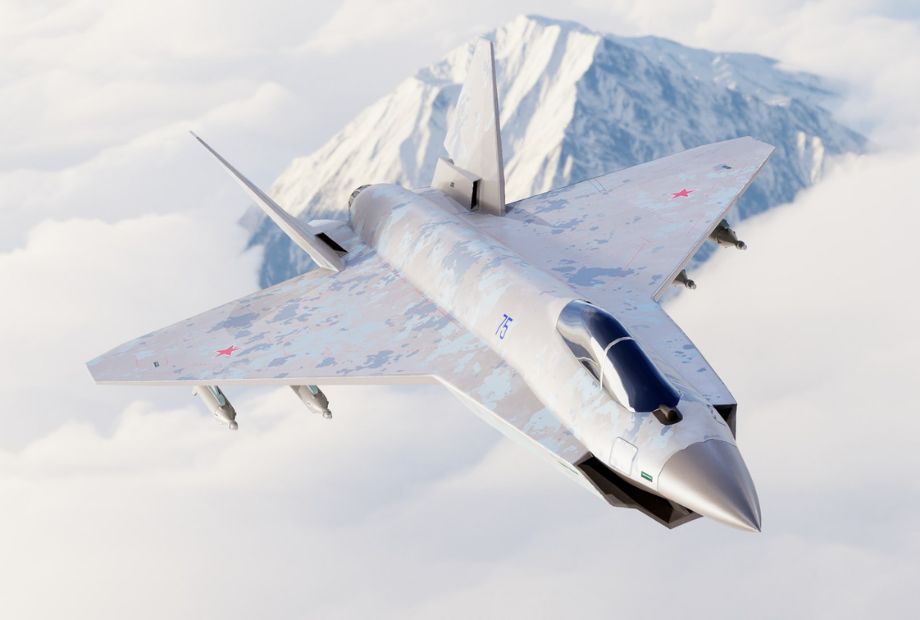Breaking news
Russian new cheap stealth fighter SU-75 facing massive export issue.
After three years since the presentation of the new stealth aircraft intended to equip the Russian Aerospace Forces by 2027, the Russians are struggling to find buyers for what is presented as a direct competitor to the American F-35. A paradox for an aircraft designed for export at low costs.
Follow Army Recognition on Google News at this link

3D modelisation of Su-75 checkmate (Picture source www.deviantart )
The Sukhoi Su-75 "CheckMate" is a stealth-capable, fifth-generation fighter jet from Russia, which was first revealed at the MAKS-2021 Air Show in July 2021. Designed to be cost-effective and export-friendly, the Su-75 is a single-engine, light tactical fighter that seeks to combine advanced avionics and weapon systems with low operational costs. It features a reduced radar cross-section for enhanced stealth capabilities, aiming to appeal to international markets that require sophisticated yet affordable military aircraft. The Su-75 is projected to start production by 2027, with Russia positioning it as a competitor to other fifth-generation fighters like the American F-35.
Despite its high-profile unveiling at an air show in 2021, Russia’s Su-75 Checkmate stealth fighter is facing headwinds in attracting international partners and competing in the global defense market. Countries like the UAE and India have not eagerly partnered in the program, indicating limited success for Moscow’s new military aircraft in the international arena. In the broader context, Russia’s standing in global arms sales has waned, coming in third behind the United States and France, the latter recently surpassing Russia’s long-held second position. This shift can be partly attributed to the negative repercussions of the ongoing conflict in Ukraine on Russia’s reputation.
The declaration of the Su-75 Checkmate’s capabilities has been inconsistent, with Russian officials providing conflicting statements regarding its stealth features—a core requirement for modern fighter jets. Financial constraints and rising development costs have impeded the program’s progress, especially as the war in Ukraine absorbs much of Russia’s defense resources.
The introduction of the Su-75 Checkmate continues a pattern of Russia promoting defense projects with significant fanfare, only for these initiatives to underperform. As seen with the T-14 Armata tank, the Su-57 Felon, and the Kh-47M Kinzhal missile, Russian military hardware has previously failed to live up to Moscow’s ambitious declarations. These arms programs have experienced technical difficulties and limited deployment, undermining their purported strategic value.
This analysis suggests that unless there are significant changes, the Su-75 may follow in the footsteps of past Russian defense projects, struggling to demonstrate its promised potential and secure its place in the competitive international market.
Russia’s aviation sector, particularly its defense component, has a storied history with significant developments like the Su-75 Checkmate stealth fighter, drawing attention at international events such as air shows. Yet, this latest entrant in stealth technology is finding it challenging to penetrate the global arms market. This difficulty is underscored by the reluctance of countries such as the UAE and India to become partners in the Su-75 program.
While current reports place Russia as the third-largest arms exporter behind the United States and France, market forecasts project a tough road ahead for Russia’s defense exports, partly due to the consequences of its actions in international conflicts that affect buyer sentiments. The global fighter jet market itself is highly competitive, with a few established players such as Lockheed Martin’s F-35 and Boeing’s F/A-18 dominating international sales. Geopolitical alliances and regional security concerns also influence the profitability and growth potential of the military aircraft industry. Manufacturers in the United States and Europe benefit from NATO partnerships and other alliances. These relationships encourage member states and allies to purchase from within their bloc, creating challenges for Russian products to gain market share.
Russia’s defense industry confronts several issues that inhibit the effectiveness and export potential of projects like the Su-75. There are reports of inconsistent declarations about the aircraft’s capabilities, particularly its stealth features—a crucial aspect of fifth-generation fighter jets. Development difficulties, coupled with financial constraints exacerbated by the ongoing conflict in Ukraine, have diverted funds and attention away from defense projects, potentially stalling progress. Challenges are not new to the Russian military industry. Historical examples like the T-14 Armata tank and the Su-57 Felon have experienced similar pitfalls, from technical problems to delayed deployment, which have ultimately compromised their competitive edge and reputation in the global market.
The trajectory of the Su-75 Checkmate suggests that without substantive advancements and a strategic overhaul, Russia may struggle to find an international foothold for its latest stealth fighter. To combat these challenges and secure a niche in the international arms marketplace, Russia will need to overcome the skepticism surrounding its military hardware, made more acute by economic sanctions and its diminished geopolitical standing.
For further information on global defense markets, interested readers can visit the website of the International Institute for Strategic Studies (IISS) at IISS, a leading authority on global security, political risk, and military conflict. Please note that while we strive to provide you with up-to-date and accurate information, it’s always best to visit the official domain for the most current insights.
Defense News April 2024























